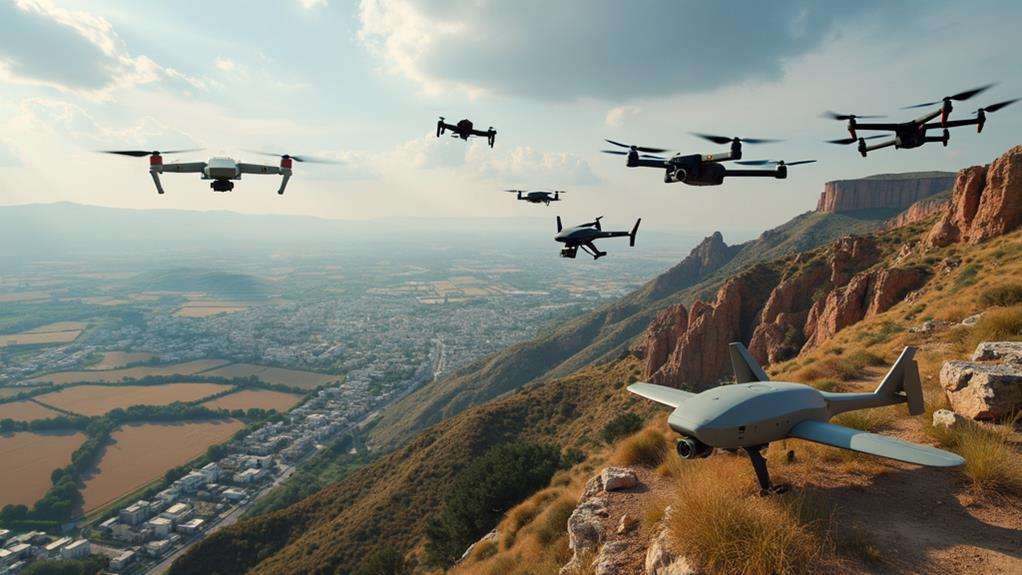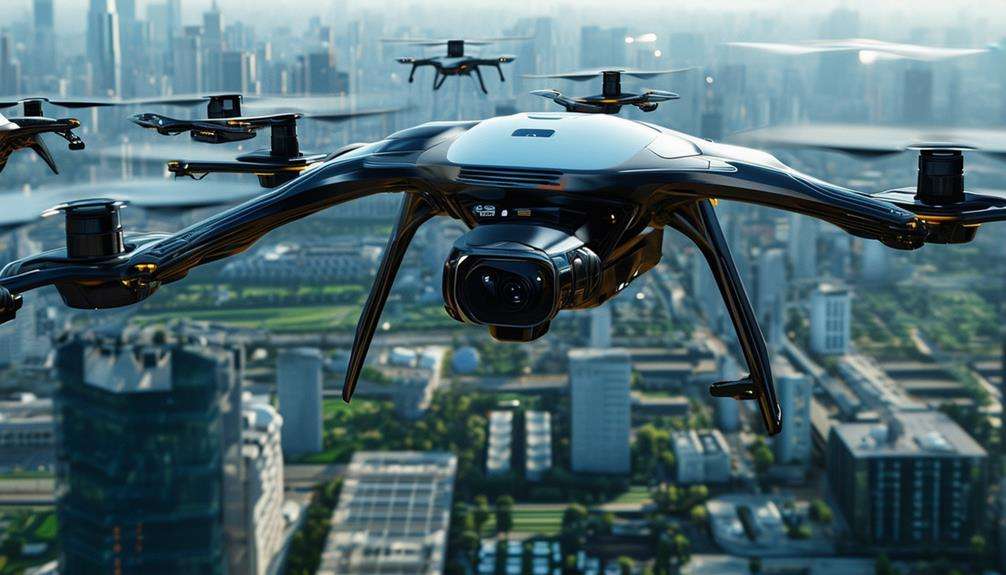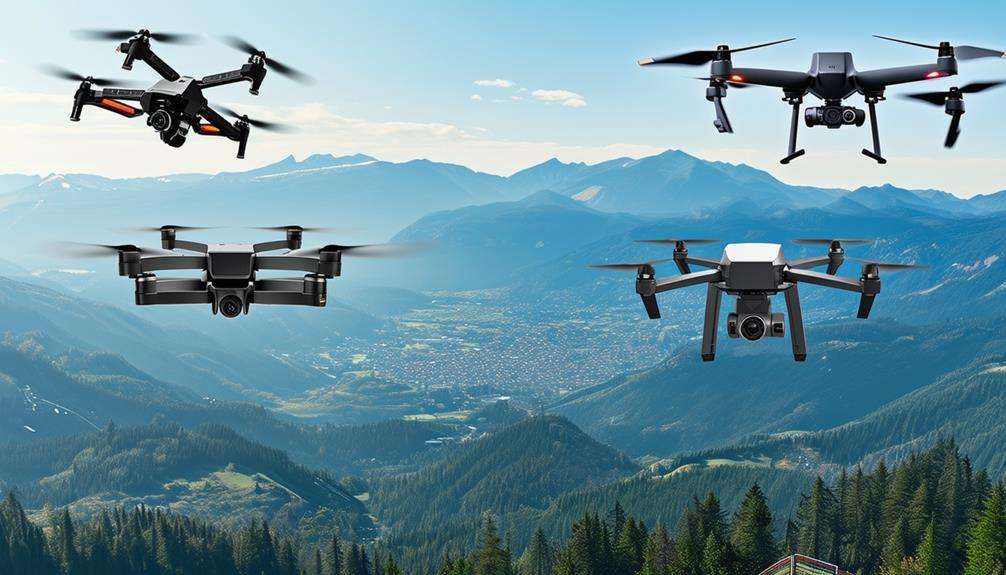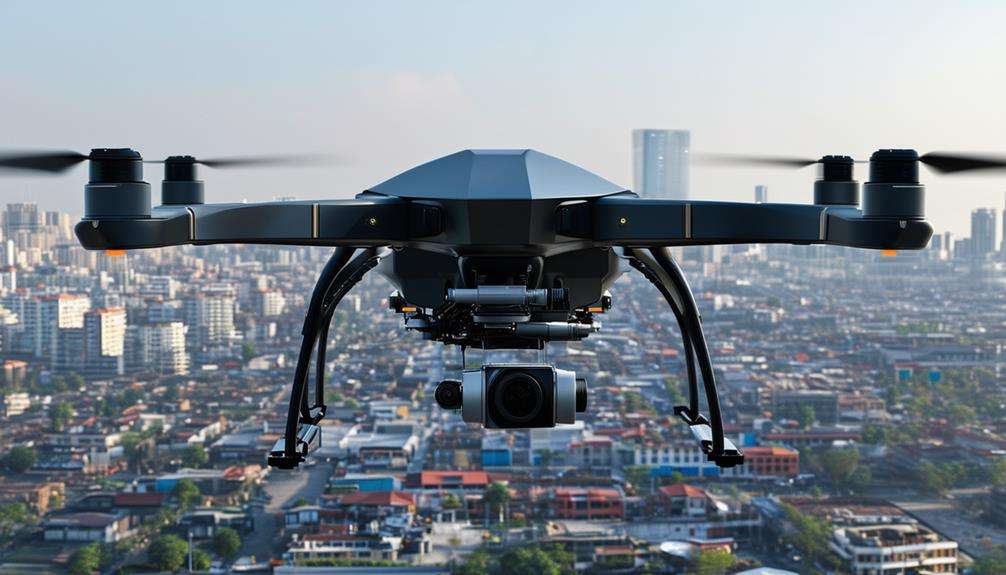From RC Planes to Drones: The Technological Leap
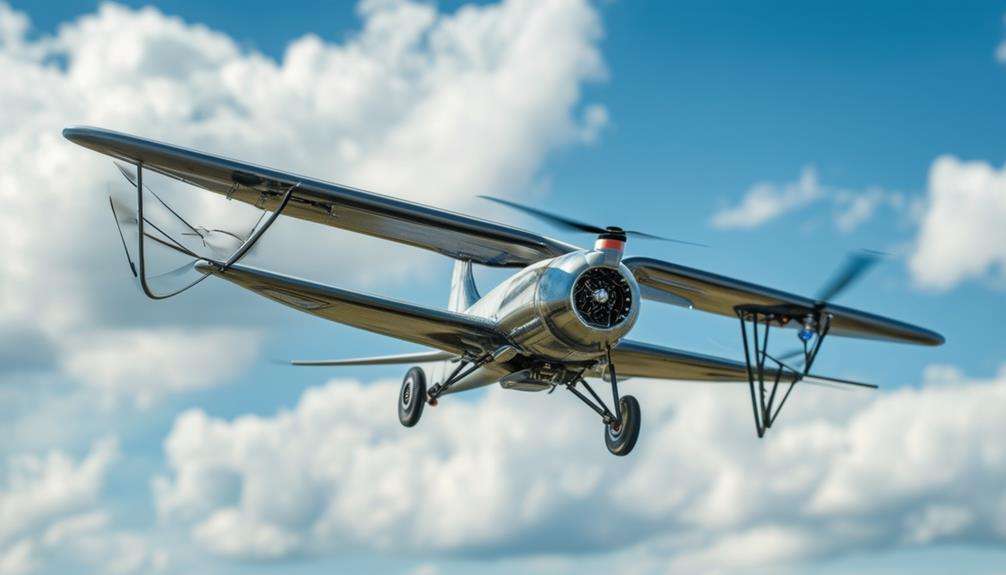
Imagine charting the evolution from the early days of RC planes to the cutting-edge world of drones. This journey reveals how advancements have revolutionized aerial technology, transitioning from basic remote controls to sophisticated autonomous systems.
Drones have vastly expanded the range and capabilities of aerial vehicles, influencing everything from military operations to consumer applications. But what exactly sets these two eras of flight technology apart, and how have these innovations shaped the future of aerial vehicles? Stay tuned to uncover the pivotal changes and exciting possibilities that lie ahead.
Evolution of RC Planes
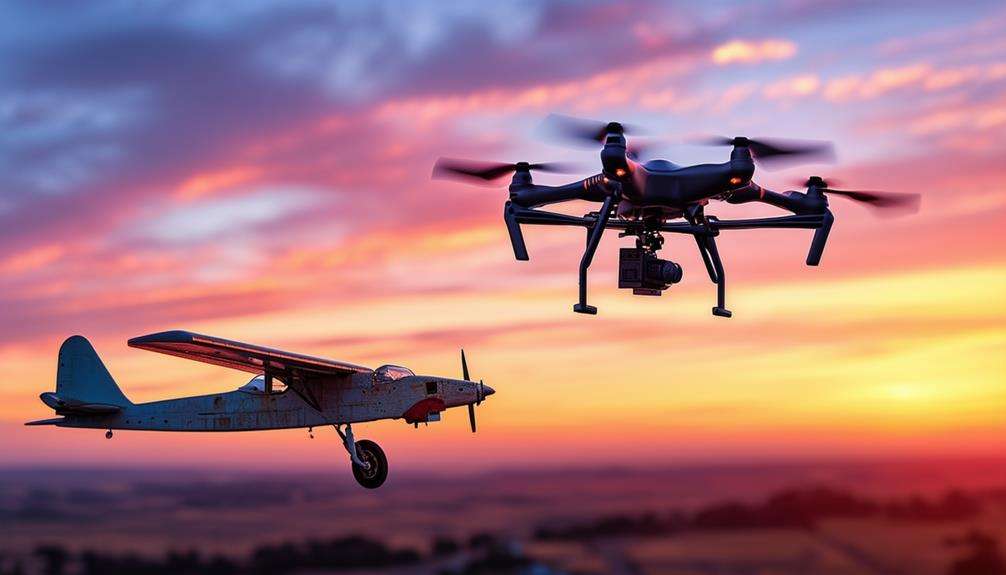
Starting in the early 20th century, RC planes have evolved from rudimentary line-controlled models to sophisticated radio-controlled aircraft with advanced technologies. The journey began with the 'Galloping Ghost,' the first RC plane flown in 1937 by Douglas and Popular Science editor Dave L. Shannon. This milestone marked the beginning of a new era in unmanned aerial flight.
Initially, RC planes were basic, offering limited control and maneuverability. The introduction of proportional radio control systems in the 1960s revolutionized the hobby. These systems provided more precise control, allowing for complex maneuvers and significantly enhancing the flying experience. As a result, the hobby gained popularity, attracting enthusiasts eager to explore the capabilities of unmanned aerial vehicles.
In modern times, RC planes are technological marvels. They feature brushless motors for improved performance, gyro stabilization for smoother flights, and even aerobatic capabilities. These advancements have transformed RC planes from mere toys into sophisticated unmanned aerial vehicles.
Today, whether you're a beginner or a seasoned pilot, you can enjoy a diverse and thrilling flying experience. The evolution of RC planes mirrors a broader trend towards more advanced and accessible unmanned aerial technology.
Rise of Drone Technology
The rise of drone technology has revolutionized various industries, from military operations to consumer markets. Tracing its origins to the late 18th century, modern drones began to take flight with the De Havilland DH.82B Queen Bee in 1935. The subsequent technological advancements have been groundbreaking.
In military applications, drones like the Predator, developed in 1996, have significantly altered the dynamics of warfare. They played a pivotal role during the Gulf War in 1991, demonstrating their strategic value and changing military tactics forever. Today, drones are essential for surveillance, reconnaissance, and targeted strikes, enhancing operational efficiency and reducing human risk.
On the consumer front, companies such as DJI have spurred innovation, integrating UAV technology into mainstream applications. From aerial photography to agricultural monitoring, the potential uses are vast. Since 2006, there has been a surge in industrial applications, with organizations leveraging drones to enhance safety and efficiency, often with the expertise of firms like Consortiq.
Key Aspects and Their Impact
| Aspect | Impact |
|---|---|
| Military Use | Enhanced surveillance and precision strikes |
| Consumer Market | Growth in recreational and professional usage |
| Industrial Applications | Improved efficiency and safety |
| Innovation Leaders | Companies like DJI at the forefront |
These facets illustrate the transformative power of drone technology across diverse sectors, showcasing its ability to drive efficiency, innovation, and strategic advantage.
Key Technological Differences
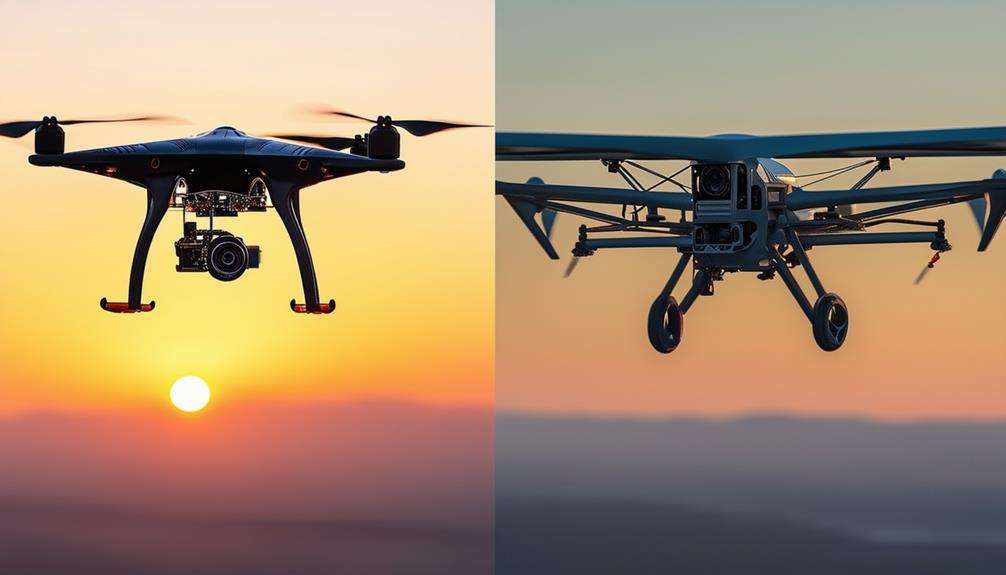
When comparing RC planes and drones, significant differences in control systems and flight capabilities become apparent. Drones use advanced flight control systems, enabling autonomous operation and the execution of complex missions. In contrast, RC planes depend on direct manual control, with generally more limited range and endurance.
Advanced Control Systems
Unlike RC aircraft that rely on manual control, UAVs utilize advanced autonomous flight systems for unparalleled precision and range. When piloting an RC aircraft, operators depend on remote control to maneuver it, typically keeping it within a 500-meter radius. In contrast, UAVs can operate independently over thousands of kilometers, thanks to their sophisticated control systems. UAVs feature a central flight control system that manages navigation, communication links, and mission-specific tasks.
Here's how UAVs surpass RC aircraft with their advanced control systems:
- Autonomous Flight: UAVs can execute pre-programmed flight paths without any manual intervention, unlike RC aircraft.
- Extended Range: UAVs aren't constrained by the operator's line of sight and can travel far beyond the 500-meter limit of RC aircraft.
- Complex Missions: UAVs are equipped for specialized missions requiring advanced navigation and control, far beyond the simpler recreational flying of RC aircraft.
- Integrated Systems: UAVs' control systems incorporate advanced navigation, communication, and mission management systems, providing superior functionality.
These advanced control systems enable UAVs to perform intricate tasks with a level of precision and range that's unattainable with traditional RC aircraft.
Enhanced Flight Capabilities
Unmanned Aerial Vehicles (UAVs) exhibit significantly enhanced flight capabilities compared to traditional Remote-Control (RC) aircraft, enabling them to perform tasks beyond the reach of RC planes. UAVs can achieve autonomous flight over extensive distances, a capability unattainable with RC planes that rely on manual control and are restricted to a 500-meter range from the operator. In contrast, UAVs are capable of covering thousands of kilometers and can remain airborne for up to 48 hours, thanks to their advanced systems.
The key to these advanced capabilities lies in the UAV's central flight control system. This sophisticated technology allows UAVs to intelligently handle various situations and execute missions autonomously. Unlike RC planes, which require continuous operator input for every maneuver, UAVs can operate with minimal human intervention, significantly extending their operational range and versatility.
UAVs are equipped with an integrated system that includes flight control, navigation, communication, and mission-specific systems. This seamless integration facilitates autonomous operations, making UAVs highly effective for a wide range of tasks, from surveillance to delivery services.
RC aircraft, typically used for recreational or ornamental purposes, can't compete with the technological advancements present in modern UAVs. Thus, using UAVs opens up a multitude of possibilities that RC planes can't offer.
Flight Control Advancements
The transition from RC planes to drones has significantly advanced flight control technology, enabling autonomous operations that can span thousands of kilometers and last up to 48 hours. This progress has fundamentally changed the operation of unmanned aircraft, allowing them to carry out intricate missions with minimal human intervention.
Unlike RC aircraft, which require constant manual control, modern UAVs employ a centralized flight control system. This system integrates various components such as navigation, communication links, and mission-specific systems. Here are the key differences these advancements bring:
- Autonomous Flight: UAVs can operate independently, following pre-programmed routes and adapting to changing conditions without real-time input from an operator.
- Extended Range: While RC planes are restricted to approximately 500 meters from the operator, UAVs can cover extensive distances, making them ideal for long-range missions.
- Enhanced Stability: Advanced algorithms and sensors enable UAVs to maintain stability and perform complex maneuvers, unlike RC aircraft that depend on the operator's skill.
- Mission-Specific Capabilities: UAVs are outfitted with specialized systems for tasks ranging from surveillance to cargo delivery, offering far greater versatility than traditional RC planes.
These innovations represent a significant leap in flight control, distinguishing UAVs from their RC predecessors.
Applications and Uses
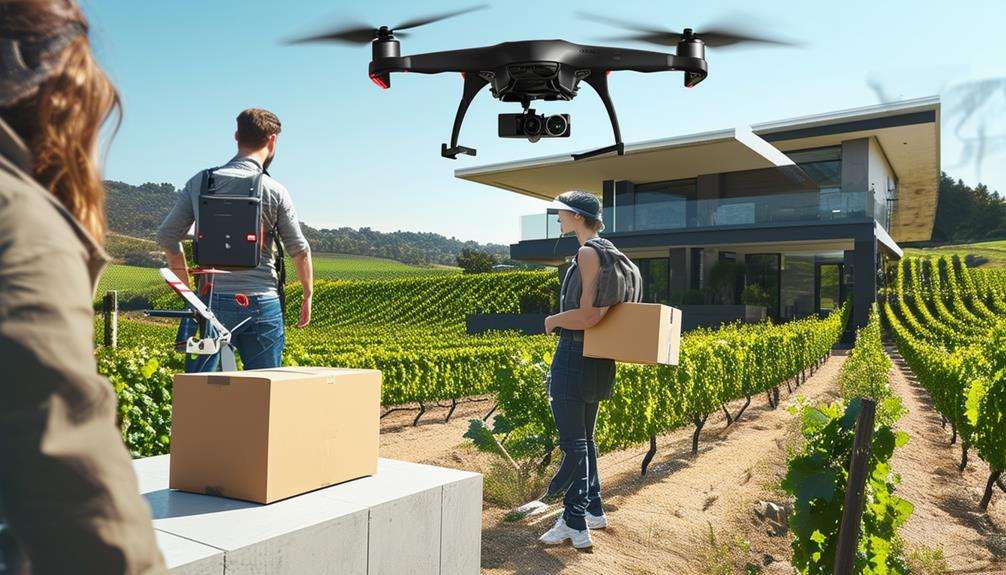
Drones have revolutionized various fields, from transforming aerial photography to enhancing agricultural monitoring. They've also proven invaluable in disaster response, offering quick and efficient solutions. Let's explore how these technological advancements impact diverse sectors.
Aerial Photography Revolution
In recent years, aerial photography has revolutionized sectors such as real estate, agriculture, and filmmaking by offering unique perspectives and cost-effective solutions. Equipped with high-resolution cameras, drones capture detailed images for mapping, surveying, and inspection purposes, significantly reducing costs and enhancing efficiency compared to traditional methods.
The variety of drone models—from basic consumer versions to advanced professional ones—ensures that there's a suitable tool for every specific task.
Consider the diverse applications of aerial photography:
- Real Estate: Drones produce stunning property videos and images, highlighting features from unique angles to make listings more attractive to potential buyers.
- Filmmaking: Directors and cinematographers use drones to capture dynamic and breathtaking shots, enriching the visual storytelling experience.
- Advertising and Tourism: High-quality aerial footage generates engaging promotional content that captivates audiences.
- Inspection and Surveying: Drones offer detailed and accurate data for infrastructure inspections and land surveys, reducing the need for manual labor and enhancing safety.
The versatility and maneuverability of drones make them indispensable for capturing dynamic and unique shots from various perspectives. This revolution in aerial photography not only enhances the quality of visual content but also streamlines processes across multiple industries.
Agricultural Monitoring Advances
Building on the transformative impact of aerial photography, agricultural drones now enable farmers to monitor crops, detect pests, and optimize irrigation with unprecedented precision. These drones capture high-resolution images, facilitating data-driven decisions that enhance crop management. Equipped with multispectral cameras, they analyze various wavelengths of light to provide detailed insights into plant health, far surpassing traditional methods.
Drones can cover large areas swiftly, significantly reducing the time and labor required for field inspections. This efficiency allows farmers to concentrate more on implementing solutions rather than merely identifying issues. The data collected from these drones aids in increasing crop yields, reducing water usage, and minimizing pesticide application, thereby promoting sustainable farming practices.
| Function | Benefit | Outcome |
|---|---|---|
| Crop Monitoring | High-resolution images | Data-driven decisions |
| Pest Detection | Multispectral analysis | Early pest identification |
| Irrigation Optimization | Quick area coverage | Efficient water usage |
| Plant Health Analysis | Light wavelength analysis | Detailed health insights |
| Field Inspection | Reduced time and labor | Focus on solution implementation |
This comprehensive approach ensures that farmers can rely on precise, actionable data to make informed decisions, fostering a more sustainable and productive agricultural practice.
Disaster Response Efficiency
Rapid advancements in UAV technology have revolutionized disaster response, significantly enhancing search and rescue operations. When disaster strikes, every second counts. Drones have become essential tools for quickly evaluating affected areas, locating survivors, and assessing damage. Their ability to deliver real-time data and imagery to emergency responders improves coordination and decision-making.
Drones offer several key benefits in disaster response:
- Speed: Drones can swiftly cover large areas, drastically reducing response times and enabling faster rescue operations.
- Accuracy: Equipped with thermal imaging cameras, drones can locate survivors in challenging environments, such as collapsed buildings or dense forests.
- Safety: By providing remote assessments, drones minimize the risk to human responders who might otherwise enter hazardous situations.
- Efficiency: Real-time data and imagery enhance resource allocation and emergency response strategies.
These advancements ensure more effective disaster management, ultimately saving lives and resources.
Safety and Security Aspects
When considering RC planes and drones, it's crucial to address the distinct safety and security challenges each presents. RC planes require constant manual control, making them highly dependent on the operator's skill. This can become a safety risk if the operator lacks experience or becomes distracted. In contrast, drones, or UAVs, can fly autonomously using a central flight control system, reducing human error but introducing potential security vulnerabilities, such as hacking.
RC aircraft are typically managed by the Air Sports Management Center and have limited range, staying within 500 meters of the operator. Their relatively short operational distance makes them less susceptible to misuse.
On the other hand, drones can travel significant distances and stay airborne for extended periods, making them more capable but also more challenging to regulate. Civil UAVs fall under the jurisdiction of the Civil Aviation Authority, while military UAVs are managed by the military, reflecting their advanced technology and potential for sensitive missions.
The ability of drones to operate autonomously and over long distances raises significant security concerns. Ensuring they're used responsibly and securely is paramount, given their capacity for extended and unsupervised flights.
Future of Aerial Innovation
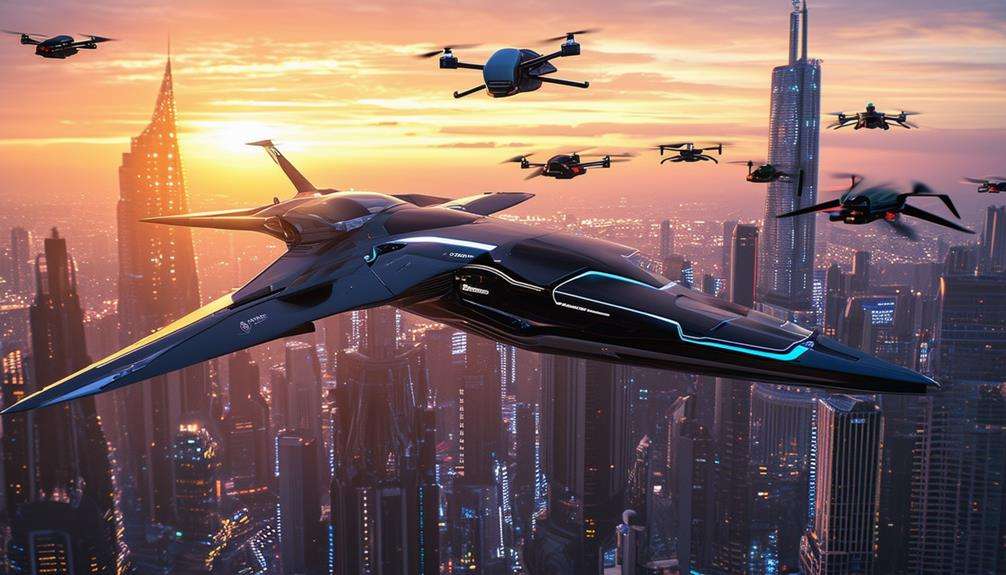
The future of aerial innovation promises groundbreaking advancements in drone technology, revolutionizing industries and transforming daily life. Expect drones equipped with advanced sensors and AI capabilities, enabling more autonomous and precise operations.
With improvements in battery technology, drones will achieve extended flight times, with some models already capable of flying for up to 48 hours. This leap in battery efficiency means drones can cover longer distances and handle more demanding tasks.
Key developments to anticipate include:
- Enhanced Payload Capacities: Drones will be able to carry heavier loads, proving invaluable for industries such as agriculture and delivery services.
- Improved Safety Features: Advances in landing systems, GPS tracking, and obstacle avoidance will ensure safer and more reliable drone operations.
- Industry Collaborations: Cross-sector integration in areas like surveillance, agriculture, and logistics will drive innovation and expand drone applications.
- AI and Sensor Integration: Drones will become even smarter, capable of complex data analysis and autonomous decision-making.
These advancements will transform how we approach everyday tasks and complex challenges, making drones not just tools but essential components of our technological ecosystem.
Conclusion
The evolution from RC planes to drones has significantly advanced aerial technology. Drones, with their sophisticated flight controls, autonomous systems, and wide-ranging applications, have revolutionized numerous industries and set the stage for continuous innovation.
As technology progresses, safety and security measures also improve. This shift highlights a future where aerial capabilities are limitless, providing endless opportunities for both hobbyists and professionals.

